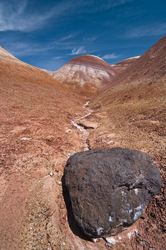Studying the effects of heat on geological repositories
Many types of radioactive waste generate heat. This must be taken into account when planning long-term underground storage solutions for nuclear waste. In response, the EURATOM Programme supported a consortium of European research institutes to study the effects of heat upon the host rock of deep geological repositories. Experiments were performed in boreholes in the field in order to obtain the most accurate results possible. A heating tube was positioned adjacent to the bentonite buffer surrounding the host rock, Opalinus clay, and maintained at a constant temperature for a period of 18 months. Experts with the Gesellschaft fuer Anlagen- und Reaktorsicherheit (GRS) mbH in Germany applied geoelectric techniques to acquire resitivity data, which provided insight into the distribution of water in the clay. Remarkably, saturation was observed to be relatively homogeneous. Only minor losses were detected near the floor and these were attributed to the development of microfissures. The researchers at GRS therefore concluded that temperatures reaching 50°C did not cause the Opalinus clay to dry out. Further study is required in order to extend this finding to temperatures approaching 100°C. Such information is essential for the proper selection and design of deep geological waste repositories.



